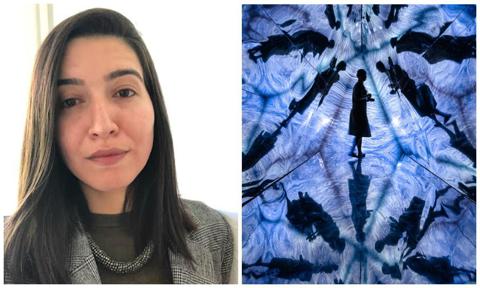
When do we believe that a certain artwork has ‘worked’? When it manages to engage with the audience on a deeply sensorial level — though this often merely takes the visual aspect into consideration, given how art forms like paintings and sculptures engage our vision more than any other senses. Sound as a sense, however, is an often overlooked aspect of art. It has a transportive power that can make a piece of work more impactful when implemented correctly.
And this is precisely what led artist and researcher Farah Mulla to employ sound as her choice of medium.It was a formative encounter with the works of American composer John Cage and a general affinity towards music that opened her up to the boundless possibilities of sound and music.
“It was the event horizon for my early experiences. In retrospect, it helped make sense of quite a few instances in my early life where I would use a portable radio and tune in to different stations during road trips, or splice up cassette tapes with recorded soundscapes during my travels, etc,” she shares.
“With sound, there’s this immaterial materiality, a persisting invisibility that’s within you and outside of you at the same time. I’m fascinated by its power, ephemerality, subtlety and the grace of its agency.”
A formal education in science fed Mulla’s curious soul and allowed her to look for the answer to the question of how things work. But it was giving up her masters in geology midway to study art that allowed her to explore her creative side. This move also enabled her to find a unique blend of science and art, which eventually became her art language.
“I don’t really see it as a point of intersection as I can’t tell one apart from the other. Both are creative and inquisitive in their approaches and have a method and madness to put meaning to matter,” she explains.
Mulla’s art installations use auditory engagements to create soundscapes that allow the listener to perceive sound in a unique manner. The process, as one can imagine, is a characteristic blend of intuitiveness and meticulous research.
“I consume a lot of random research papers, music and ambience sounds on the regular. I tend to not play push or pull with ideas. They somehow find their connections in due time. Connections emerge from within these learnings and transform into ideas and installations,” she says.
Her unconventional choice of medium has not only led her to carve a niche in the art community — and earn herself an award for Breakthrough Artist of the Year at the HELLO!
India Art Awards — but also witness people from all walks of life interact with her sound art installations and let their imagination run wild. An experience at the 2019 Serendipity Arts Festival in Panjim still sticks out for her… “My most memorable experience was at Serendipity when they brought in children from the local school for the visually and auditorily impaired. The experience of watching the kids and teachers interact with a sound installation, and for them to perceive it in a manner that made sound legible to them, is etched in my memory.”
When asked which aspects of her forthcoming work she’s excited about, the artist excitedly replies, “Spreading my roots in experimental music cultures, new experiments and the upcoming projects that unfurl this year. Grab a seat!
- Quick links
- Farah Mulla
- Art
- artist






